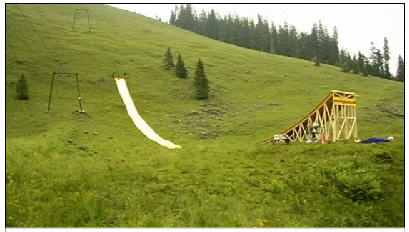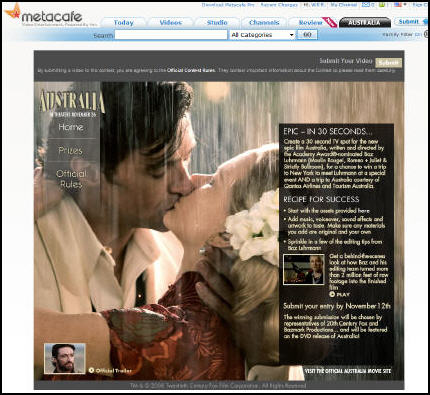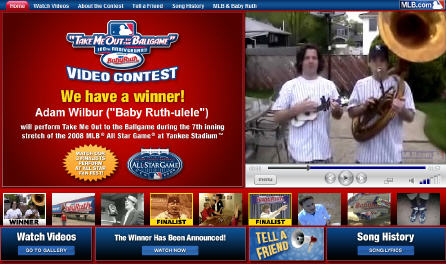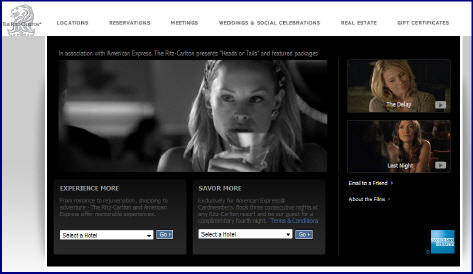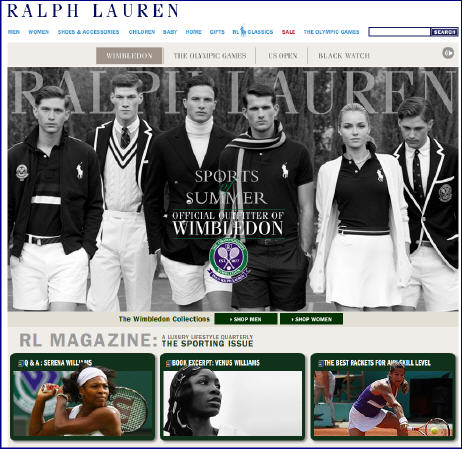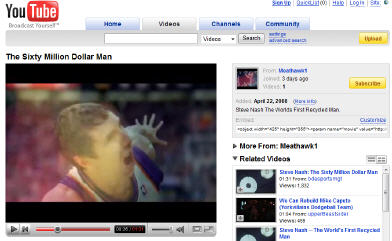-
How I Got Punked by the Megawoosh Waterslide Video
In last Friday's "4 Items Worth Noting..." post, I made a quick reference to the Megawoosh Waterslide video - what I thought was a genuine user-generated video of a German man barreling down a huge waterslide into a small pool. It turns out that I, along with many others, got punked. It's a fake, created through effects by a German marketing firm and sponsored by Microsoft Office. If you want all the details, NewTeeVee has a great write-up.
The waterslide incident contrasts with a second incident that happened to me just two weeks earlier. Taken together, I think the two represent a fascinating, yet unexplored side-effect of the broadband video revolution that all of us as human beings are currently experiencing. Let me explain what I mean.
In July 31st VideoNuze Report podcast, Daisy Whitney was very excited to describe the "JK Wedding March" viral video phenomenon (19 million + views to date) and how YouTube was publicizing on its blog that it was generating exceptional click-throughs and revenue for the video's background song "Forever" by Chris Brown through overlay ads.
When I quickly watched the video, my internal "authenticity detector" went off loudly as I wondered whether the wedding march was authentic or simply staged to generated buzz and sales for the song. I expressed this skepticism to Daisy on the podcast, and it wasn't until I did further research, and found the young Minnesota wedding couple interviewed on the "Today" show that my suspicions were allayed.
Meanwhile, when I quickly watched the Megawoosh video I thought, hey, it's an outlandish stunt. I wondered about the engineering involved to pull it off, but my authenticity meter remained relatively quiet.
Here's what I think the difference is: In the JK Wedding March I saw an obvious commercial opportunity that made me suspicious, while with the Megawoosh slide I did not see such opportunities so I was more willing to accept it as genuine. My authenticity lens has been shaped by having watched many broadband videos over the years where brands were involved in subtle and clever ways that I've become very aware. On the flip side, I've seen so many incredible user-generated stunts, that I've become conditioned to thinking that just maybe, anything is possible to pull off and some people's willingness to risk injury and death in the name of fleeting celebrity is unlimited.
The larger point here is that broadband video puts all of us in unchartered waters with respect to understanding if what we're watching is real. In the past, we rarely needed to question this. We knew when we were watching special effects or a documentary, reality programming or scripted fiction. And when authenticity representations were breached, it was a big deal (remember the outcry when NBC's "Dateline" admitted staging a test crash of a GM pickup truck?).
With broadband video however, we often don't even know who the producers are, much less what hidden motivations they may have or what third parties may be involved. Sometimes things are incongruous - for example, why is Microsoft Office even involved in sponsoring this German waterslide stunt?
Bottom line: all of us are on a new learning curve, requiring that we develop entirely new media literacy skills so we can successfully navigate broadband video's unchartered territory.
What do you think? Post a comment now.
Categories: Brand Marketing, UGC, Video Sharing
Topics: Microsoft, NBC, YouTube
-
VideoNuze Report Podcast #24 - July 24, 2009
After several weeks of holidays and vacations, Daisy Whitney and I are back on track this week with our 24th podcast of the year, for July 24, 2009.
This week Daisy and I dig into YouTube from two different angles. Daisy picks up on a piece she wrote that explains the success YouTube is having attracting brands to set up their own channels within the site. These channels can cost up to $200K or more per year. However, there are lots of less expensive ways to work with YouTube, and as Daisy explains, with video helping drive purchase intent, it's a prerequisite that every brand should now have some type of a video presence there.
Despite this, as I wrote earlier this week in "Google is Being Clumsy in Explaining YouTube's Performance," I think YouTube's progress isn't being messaged very well to the market. In its recent Q2 earnings call, a supplementary analyst call and a blog post earlier this week, Google executives sent confusing and sometimes unsupported messages about how far along they are in figuring out to monetize YouTube's premium content-oriented traffic. Given YouTube's bellwether status in the industry, it is being closely watched by many for signs of success or failure.
Click here to listen to the podcast (14 minutes, 6 seconds)
Click here for previous podcasts
The VideoNuze Report is available in iTunes...subscribe today!
Categories: Aggregators, Brand Marketing, Podcasts
-
4 News Items Worth Noting from the Week of July 13th
Following are 4 news items worth noting from the week of July 13th:TV Everywhere survey should have cable industry clicking their heels - I wasn't at all surprised to read results of a new Solutions Research Group survey fielded to 500 Comcast and Time Warner Cable subscribers giving the concept of TV Everywhere positive reviews. As Multichannel News reported, in the overall survey 28% of respondents said the idea was "excellent" and 45% said it was "good." Digging in further though, among those 18-49 the "excellent" score surged to 80%, while 87% of Hulu and Fancast users approved of the idea. Unprompted, respondents cited benefits like convenience, remote viewing, getting better value from their cable subscriptions, watching on PCs in rooms without TVs and catching up on missed programs. My take: consumers "get" what TV Everywhere is all about and already have positive initial reactions, meaning there's very significant upside for the cable industry.Paid video forecast to surpass free - A Strategy Analytics forecast that got attention this week says that the global paid online video market will be worth $3.8B in 2009, exceeding the global free online video segment which will total $3.5B. I haven't seen the details of the forecast, but I'm very curious what's being included in each of these numbers as both seem way too high to me. The firm forecasts the two segments to grow at comparable rates (37% and 39%), suggesting that their size will remain relatively even. I suspect we're going to be seeing a lot of other research suggesting the paid market is going to be far larger than the ad-supported market as sentiment seems to be shifting toward subscriptions and paid downloads.
Consumer generated video contests remain popular - VideoNuze readers know I've been intrigued for a while now about contests that brands are regularly running which incent consumers to create and submit their own videos. Just this week I read about two more brands jumping on the bandwagon: Levi's and Daffy's retail stores. NewTeeVee had a good write-up on the subject, citing new research from Forrester which reviewed 102 different contests and found the average prize valued at $4,505. I see no end in sight for these campaigns as the YouTube generation realizes it's more lucrative to pour their time into these contests than training their cats to skateboard. Brands too are recognizing the wealth of amateur (read cheap!) talent out there and are moving to harness it.
MySpace has lots of work ahead to become a meaningful entertainment portal - The WSJ ran a piece on Monday based on an interview with Rupert Murdoch in which he was quoted as saying MySpace will be refocused "as an entertainment portal." That may be the winning ticket for MySpace, but I'm not totally convinced. MySpace has been in a downward spiral lately, with a 5% decline in audience over the past year, a 30% headcount reduction and an executive suite housecleaning. While always strong in music, according to comScore, its 48 million video viewers in April '09 were less than half YouTube's 108 million, while its 387 million video views were about 5% of YouTube's 6.8 billion. Clearly MySpace has a very long way to go to give YouTube serious competition. It will be interesting to see if the new management team Murdoch has installed at MySpace can pull off this transition.
Categories: Aggregators, Brand Marketing, Cable Networks, Cable TV Operators, UGC
Topics: Comcast, Forrester, MySpace, Strategy Analytics, Time Warner
-
4 Industry Items from this Week Worth Noting - 7-2-09
Clearleap announces Atlantic Broadband as first public customer - Clearleap, the Internet-based technology firm I wrote about here, announced Atlantic Broadband as its first public customer. Atlantic is the 15th largest cable operator in the U.S. I spoke with David Isenberg, Atlantic's VP of Products, who explained that Clearleap was the first packaged solution he's seen that allows broadband video to be inserted into VOD menus without the need for IT resources to be involved. Atlantic initially plans to use Clearleap to insert locally-oriented videos into its local programming lineup. It also has special events planned like "Operation Mail Call." which allows veterans' families to upload videos, plus coverage of local sports, and eventually filtered UGC. By blending broadband with VOD, Isenberg thinks Clearleap gives him a "giant marketing tool" to raise VOD's visibility. As I've said in the past, VOD and broadband are close cousins which can be mutually reinforcing; Clearleap facilitates this relationship.
New Balance's "Made in USA" video - Have you seen the new 3 minute video from athletic shoemaker New Balance? Yesterday I noticed a skyscraper ad for it at NYTimes.com and a full back-page ad in the print version of the Boston Globe. New Balance's video promotes the fact that it's the only athletic shoemaker still manufacturing in the U.S. (though it says only 25% of its shoes are made here). There's also a fundraising contest to win a trip to one of its manufacturing facilities. Taking ads in online and offline media to drive viewership of a brand's original video is another way that advertising is being reimagined and customers are being engaged.
Joost - R.I.P.-in-Waiting - There's been a lot written this week about Joost's decision to switch business models from content aggregation to white label video platform provider. Regrettably, I think this is Joost's last gasp and they are in "R.I.P.-in-waiting" mode. Joost, which started off with lots of buzz and financing ($45M) by the co-founders of Skype and Kazaa, is a cautionary tale of how quickly the broadband video market is moving, and how those out of step can get shoved aside. Joost made a critical strategic blunder insisting on a client download based on P2P delivery when the market was already moving solidly in the direction of browser-based streaming. It never recovered. Given how crowded the video platform space is, I'm hard-pressed to see how Joost will carve out a substantial role.
Cablevision wins its network DVR case - Not to be missed this week was the U.S. Supreme Court's decision to refuse to hear an appeal from programmers regarding cable operator Cablevision's "network DVR" plan. The decision means Cablevision can now deploy a service that allows subscribers to record programs in a central data center, rather than in their set-top boxes. This leads to lower capex, fewer truckrolls, and more storage capacity for consumers. There's also an intersection point with "TV Everywhere," as cable subscribers will potentially have yet another remote viewing option available to them. Content is increasingly becoming untethered to any specific box.
Categories: Aggregators, Brand Marketing, Cable TV Operators, DVR, Technology, Video On Demand
Topics: Atlantic Broadband, Cablevision, Clearleap, Joost, New Balance
-
Learning from TurnHere's Strong 2009 Growth
Given the pervasiveness of gloomy economic news, I'm always on the lookout for evidence of growth, especially in the broadband video space. That's why news that TurnHere, the broadband video production and advertising company, shared with me last week caught my attention. The company will report later this morning that its business has doubled in '09 vs. '08. John McWeeny, TurnHere's COO briefed me last week on what's behind the improved numbers. Understanding TurnHere's model offers plenty of lessons for other broadband video market participants.
As background, TurnHere has developed a global network of 7,000+ independent filmmakers, which it taps into for soup-to-nuts creation of made-for-broadband content for its clients. TurnHere only accepts into the network well-credentialed professionals who are thoroughly vetted. The company's clients come from two
 sources. First, from channel resellers, who are primarily Internet Yellow Pages companies selling online ads to local businesses that increasingly want a video presence online. And second, through direct sales to brands who increasingly want to capitalize on video's impact on their web sites. '09 growth is coming in equal parts from both sides of the business.
sources. First, from channel resellers, who are primarily Internet Yellow Pages companies selling online ads to local businesses that increasingly want a video presence online. And second, through direct sales to brands who increasingly want to capitalize on video's impact on their web sites. '09 growth is coming in equal parts from both sides of the business.Listening to John describe TurnHere's business, I was repeatedly struck by the fact that this is a pretty complicated business to run successfully. Clients are in multiple locations, necessitating multiple filmmakers to be involved in projects. Yet brand standards and formats must be adhered to for consistency across videos. And often there's a 3rd party agency or marketing/online consultant involved that must be pleased as well. Tight budgets and timelines are the norm. So making all this work is not trivial. In fact John remarked that one of the company's core competencies is "how to leverage a distributed network of creative people." That seemed like a spot-on assessment to me.
To succeed, TurnHere has developed strict internal policies and procedures to guide its work. Everything from recruiting filmmakers to selecting them for projects to scoping the project with clients to managing the video production process to reviewing filmmakers' work has some formal structure around it. John explained a key differentiator for TurnHere is its laser focus on video that is made-for-broadband. The company is not aiming to make commercials that run on-air and cost hundreds of thousands of dollars. Rather, it looks to produce high-quality, yet inexpensive shorts in a documentary-style, with real people, not actors.
The result is that for clients used to getting just one ad for their budget, they are now getting dozens or even hundreds of web-only videos. TurnHere's surging business is due to more marketing executives opting to allocate budget to the new broadband video medium to reach their target audience vs. following traditional TV advertising rules. When you read research about ad budgets shifting to online, TurnHere is right on the front lines of making this happen. The company has done work for brands like InterContinental Hotels, Williams-Sonoma, American Express and others.
Emphasizing attributes like process development, specialization, customization, flexibility, affordability, reach and quality are the reasons TurnHere is succeeding, despite the down economy. In fact, a lot of what John said echoed what Demand Studios' EVP Steven Kydd told me recently. Demand Studios too is focused on building processes to crank out large volumes of high-quality web-only video. Yesterday's post on how SundaySky is enabling automated video from web-based content is yet another example volume-based video production.
The common themes here are that broadband video is a different medium than TV. People who want to succeed in the broadband video medium - whether as content providers themselves or in service to content providers or brands - need to recognize the differences and engineer their businesses appropriately. Scale and cost-efficiency matter a lot more in broadband than they did in TV where expensive, hand-crafted video was the norm. In this context, learning how to blend technology with creative talent is going to be a real competitive differentiator.
What do you think? Post a comment now.
Categories: Brand Marketing, Indie Video
Topics: TurnHere
-
Reviewing My 6 Predictions for 2008
Back on December 16, 2007, I offered up 6 predictions for 2008. As the year winds down, it's fair to review them and see how my crystal ball performed. But before I do, a quick editorial note: each day next week I'm going to offer one of five predictions for the broadband video market in 2009. (You may detect the predictions getting increasingly bolder...that's by design to keep you coming back!)
Now a review of my '08 predictions:
1. Advertising business model gains further momentum
I saw '08 as a year in which the broadband ad model continued growing in importance as the paid model remained in the back seat, at least for now. I think that's pretty much been borne out. We've seen countless new video-oriented sites launch in '08. To be sure many of them are now scrambling to stay afloat in the current ad-crunched environment, and there will no doubt be a shakeout among these sites in '09. However, the basic premise, that users mainly expect free video, and that this is the way to grow adoption, is mostly conventional wisdom now.
The exception on the paid front continues to be iTunes, which announced in October that it has sold 200 million TV episode downloads to date. At $1.99 apiece, that would imply iTunes TV program downloads exceed all ad-supported video sites to date. The problem of course is once you get past iTunes things fall off quickly. Other entrants like Xbox Live, Amazon and Netflix are all making progress with paid approaches, but still the market is held back by at least 3 challenges: lack of mass broadband-to-the-TV connectivity, a robust incumbent DVD model, and limited online delivery rights. That means advertising is likely to dominate again in '09.
2. Brand marketers jump on broadband bandwagon
I expected that '08 would see more brands pursue direct-to-consumer broadband-centric campaigns. Sure enough, the year brought a variety of initiatives from a diverse range of companies like Shell, Nike, Ritz-Carlton, Lifestyles Condoms, Hellman's and many others.
What I didn't foresee was the more important emphasis that many brands would place on user-generated video contests. In '08 there were such contests from Baby Ruth, Dove, McDonald's, Klondike and many others. Coming up in early '09 is Doritos' splashy $1 million UGV Super Bowl contest, certain to put even more emphasis on these contests. I see no letup in '09.
3. Beijing Summer Olympics are a broadband blowout
I was very bullish on the opportunity for the '08 Summer Games to redefine how broadband coverage can add value to live sporting events. Anyone who experienced any of the Olympics online can certainly attest to the convenience broadband enabled (especially given the huge time zone difference to the U.S.), but without sacrificing any video quality. The staggering numbers certainly attested to their popularity.
Still, some analysts were chagrined by how little revenue the Olympics likely brought in for NBC. While I'm always in favor of optimizing revenues, I tried to take the longer view as I wrote here and here. The Olympics were a breakthrough technical and operational accomplishment which exposed millions of users to broadband's benefits. For now, that's sufficient reward.
4. 2008 is the "Year of the broadband presidential election"
With the '08 election already in full swing last December (remember the heated primaries?), broadband was already making its presence known. It only continued as the year and the election drama wore on. As I recently summarized, broadband was felt in many ways in this election cycle. President-elect Obama seems committed to continuing broadband's role with his weekly YouTube updates and behind-the-scenes clips. Still, as important as video was in the election, more important was the Internet's social media capabilities being harnessed for organizing and fundraising. Obama has set a high bar for future candidates to meet.
5. WGA Strike fuels broadband video proliferation
Here's one I overstated. Last December, I thought the WGA strike would accelerate interest in broadband as an alternative to traditional outlets. While it's fair to include initiatives like Joss Wheedon's Dr. Horrible and Strike.TV as directly resulting from the strike, the reality is that I believe there was very little embrace of broadband that can be traced directly to the strike (if I'm missing something here, please correct me). To be sure, lots of talent is dipping its toes into the broadband waters, but I think that's more attributable to the larger climate of interest, not the WGA strike specifically.
6. Broadband consumption remains on computers, but HD delivery proliferates
I suggested that "99.9% of users who start the year watching broadband video on their computers will end the year no closer to watching broadband video on their TVs." My guess is that's turned out to be right. If you totaled up all the Rokus, AppleTVs, Vudus, Xbox's accessing video and other broadband-to-the-TV devices, that would equal less than .1% of the 147 million U.S. Internet users who comScore says watched video online in October.
However, there are some positive signs of progress for '09. I've been particularly bullish on Netflix's recent moves (particularly with Xbox) and expect some other good efforts coming as well. It's unlikely that '09 will end with even 5% of the addressable broadband universe watching on their TVs, but even that would be a good start.
Meanwhile, HD had a banner year. Everyone from iTunes to Hulu to Xbox to many others embraced online HD delivery. As I mentioned here, there are times when I really do catch myself saying, "it's hard to believe this level of video quality is now available online." For sure HD will be more widely embraced in '09 and quality will get even better.
OK, that's it for '08. On Monday the focus turns to what to expect in '09.
What do you think? Post a comment now.
Categories: Advertising, Aggregators, Brand Marketing, Devices, HD, Indie Video, Politics, Predictions, Sports, Technology, UGC
Topics: Amazon, Apple, AppleTV, Barack Obama, Hulu, iTunes, NBC, Netflix, Olympics, Roku, VUDU, XBox
-
Fox, Metacafe Have a Winner with New "Australia" Contest
This morning Twentieth Century Fox and Metacafe are announcing "The Thirty Second Film Contest," which challenges contestants to put together a winning thirty second spot for the epic film "Australia," opening on November 26th. Though not yet fully live, I like the direction of this initiative a lot, and believe it provides an innovative example of how to blend traditional film marketing techniques with broadband-enabled audience participation.
Contestants visit the promotional site hosted at Metacafe, a large aggregator of short-form entertainment, to obtain film-related assets provided by Fox. These can be augmented with the contestant's own music, voiceovers, sound effects and artwork to create a highly original entry. Entries are submitted through Metacafe and will be judged by the folks at Fox and Bazmark (Australia director Baz Luhrman's company).
The contest is actually meant to be quite serious and semi-professional; Luhrmann has also created a whole library of videos about film-making, which a student of the art can use to help shape his/her entry, or just watch to learn. The grand prize is enticing: a trip for two to Australia, another to NY for a private screening/meeting with Luhrmann and inclusion of the winning entry on the film's eventual DVD.
The Australia contest builds on a similar one that Metacafe and Universal offered for "The Bourne Ultimatum" last year, which I reviewed enthusiastically here. The concept also follows on previous posts I've done about the value of what I call "purpose-driven user generated video" or "YouTube 2.0" opportunities for users to create videos that have actual business value. I continue to believe that user-submitted videos which go beyond goofball entertainment are a huge area of broadband industry opportunity.
The Australia contest is a winner on multiple levels as it; creates pre-release buzz for the film, allows fans and aspiring artists to get involved and showcase their work, taps into a large base of original (and free!) ideas to help promote the movie, and introduces a fresh, updated approach to film marketing that is sorely needed for differentiation.
This week I've been talking a lot about engagement and why it's so critical in the broadband era. While media and entertainment companies must always focus on driving ratings points or a big opening day box office, the ways to do so are changing. The key change I see is that films, TV programs and other entertainment must become part of a larger experience - complete with multifaceted engagement opportunities - rather than just a one-off moment of audience consumption. Broadband enables this shift in a big way. More marketers need to take advantage of the possibilities.
What do you think? Post a comment now!
Categories: Aggregators, Brand Marketing, FIlms, UGC
Topics: Bazmark, FOX, MetaCafe, Universal, YouTube
-
September '08 VideoNuze Recap - 3 Key Themes
Welcome to October. Recapping another busy month, here are 3 key themes from September:
1. When established video providers use broadband, it must be to create new value
Broadband simultaneously threatens incumbent video businesses, while also opening up new opportunities. It's crucial that incumbents moving into broadband do so carefully and in ways that create distinct new value. However, in September I wrote several posts highlighting instances where broadband may either be hurting existing video franchises, or adding little new value.
Despite my admiration for Hulu, in these 2 posts, here and here, I questioned its current advertising implementations and asserted that these policies are hurting parent company NBC's on-air ad business. Worse yet, In "CNN is Undermining Its Own Advertisers with New AC360 Live Webcasts" I found an example where a network is using broadband to directly draw eyeballs away from its own on-air advertising. Lastly in "Palin Interview: ABC News Misses Many Broadband Opportunities" I described how the premier interview of the political season produced little more than an online VOD episode for ABC, leaving lots of new potential value untapped.
Meanwhile new entrants are innovating furiously, attempting to invade incumbents' turf. Earlier this week in "Presidential Debate Video on NYTimes.com is Classic Broadband Disruption," I explained how the Times's debate coverage positions it to steal prime audiences from the networks. And at the beginning of this month in "Taste of Home Forges New Model for Magazine Video," I outlined how a plucky UGC-oriented magazine is using new technology to elbow its way into space dominated by larger incumbents.
New entrants are using broadband to target incumbents' audiences; these companies need to bring A-game thinking to their broadband initiatives.
2. Purpose-driven user-generated video is YouTube 2.0
In September I further advanced a concept I've been developing for some time: that "purpose-driven" user-generated video can generate real business value. I think of these as YouTube 2.0 businesses. Exhibit A was a company called Unigo that's trying to disrupt the college guidebook industry through student-submitted video, photos and comments. While still early, I envision more purpose-driven UGV startups cropping up in the near future.
Meanwhile, brand marketers are also tapping the UGV phenomenon with ongoing contests. This trend marked a new milestone with Doritos new Super Bowl ad contest, which I explained in "Doritos Ups UGV Ante with $1 Million Price for Top-Rated 2009 Super Bowl Ad." There I also cataloged about 15 brand-sponsored UGV contests I've found in the last year. This is a growing trend and I expect much more to come.
3. Syndication is all around us
Just in case you weren't sick of hearing me talk about syndication, I'll make one more mention of it before September closes out. Syndication is the uber-trend of the broadband video market, and several announcements underscored its growing importance.
For example, in "Google Content Network Has Lots of Potential, Implications" I described how well-positioned Google is in syndication, as it ties AdSense to YouTube with its new Seth MacFarlane "Cavalcade of Cartoon Comedy" partnership. The month also marked the first syndication-driven merger, between Anystream and Voxant, a combination that threatens to upend the competitive dynamics in the broadband video platform space. Two other syndication milestones of note were AP's deal with thePlatform to power its 2,000+ private syndication network, and MTV's comprehensive deal with Visible Measure to track and analyze its 350+ sites' video efforts.
I know I'm a broken record on this, but regardless of what part of the market you're playing in, if you're not developing a syndication plan, you're going to be out of step in the very near future.
That's it for September, lots more planned in October. Stay tuned.
What do you think? Post a comment!
Categories: Aggregators, Analytics, Brand Marketing, Broadcasters, Magazines, Partnerships, Syndicated Video Economy, UGC
Topics: ABC, Anystream, AP, CNN, Doritos, Google, Hulu, MTV, NY Times, Taste of Home, thePlatform, Unigo, Visible Measu, Voxant, YouTube
-
Doritos Up UGV Ante with $1 Million Prize for Top-Rated 2009 Super Bowl Ad
The frenzy around user-generated video ads hit a new peak yesterday as Frito-Lay announced it is offering a $1 million prize to an amateur who creates a Doritos ad that scores the highest rank in USA Today's Super Bowl Ad Meter.
I believe the new campaign, which comes on top of 2 previously successful Super Bowl user-generated video ("UGV") ad contests from Doritos, is a sure-fire winner for the brand. It reflects some very smart thinking by Doritos' executives and will further accelerate the very significant trend around brand-sponsored UGV contests (see chart below for examples of UGV contests that have run in the past year). I've been writing about the UGV ad craze for a while now on VideoNuze and I see it driving continued evolution in brand-agency relations.
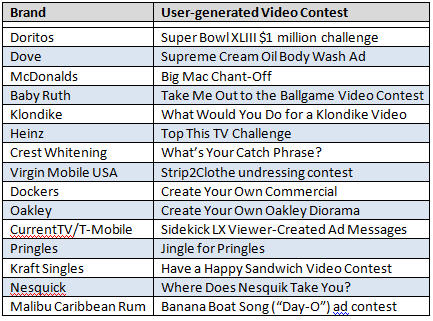
The new Doritos UGV campaign works for a variety of reasons. First and foremost, the top prize, and the four finalist prizes of $25,000 and a trip to the Super Bowl, are all very enticing awards, certain to drive tons of submissions. Winning the top prize - which requires the #1 rank in the USA Today Ad Meter - is a big-time challenge, but it is seriously aided by all the pre-game publicity this contest will be receiving. Doritos is cleverly stoking things by positioning the ad as an opportunity to "take down the big guys" - an obvious reference to Anheuser-Busch which has won the #1 rank for the last 10 years. With "Yes We Can" and "Yes We Will" political slogans ascendant, "power to the people" pitches like the one Doritos is making have a nice tailwind on their side.
This pre-game buzz means Super Bowl viewers are specifically going to be on the lookout for the Doritos UGV ad, helping its rank. Of course if you're an advertiser, especially in this ad-skipping era, viewer anticipation for your ad is close to nirvana as it gets. It builds brand awareness, engagement and presumably sales...3 big wins when you're spending an estimated $3 million for a 30 second Super Bowl ad. And of course, just think about all the free market research Doritos is collecting along the way, as loyal buyers showcase their thoughts and feelings about the product and brand.
In fact, it's Doritos' decision to morph a conventional Super Bowl ad buy into a broadband-centric, user-oriented campaign that's truly noteworthy here. VideoNuze readers know that I've been ranting for 3 straight Super Bowls that broadband opens up all kinds of new creative avenues for brands to extract new value from their game-day spending and generate a far-better ROI on the insane prices they're required to pay for this once a year extravaganza.
I have been appalled at how few Super Bowl advertisers have actually seized their broadband opportunities (note having ads playing in post-game online galleries is nice, but nowhere near what broadband is capable of). All of this has caused me to wonder whether agencies, and brands, were hopelessly oblivious to broadband's emerging role.
Doritos clearly is not among those trapped in yesterday's advertising thinking. It seems to get what broadband can do for its brand and its Super Bowl ad strategy. With its new UGV campaign, the ROI that Doritos will get on its actual game-day spend will far surpass those of its competitors. With luck that should help spur others to focus more on broadband in their future Super Bowl ads.
What do you think? Post a comment!
Categories: Brand Marketing, Sports, UGC
Topics: Anheuser-Busch, Doritos, Frito-Lay
-
Friday Fun from Bio-Rad and Eppendorf
Ending the week on a lighter note, I want to point out two videos sure to make you chuckle. If you're thinking they're from late-night comedians or new online comedy networks or even YouTube's user-generated video trove, think again. They're from about the most unlikely place you can imagine: the life sciences industry.
That's right, two life sciences companies, Bio-Rad Laboratories and Eppendorf AG are demonstrating that the so-called "democratization of video" has truly reached into some unexpected places.
The funnier of the two is Bio-Rad's "Scientists for Better PCR," a hilarious and campy imitation of "We Are the World" featuring a collection of singer lookalikes (I spotted Bob Dylan, Bette Midler, Stevie Wonder, Joe Cocker, Quincy Jones and others...see who you can identify). Also, it's worth clicking on the "Download the Lyrics" link to see the actual words they're singing - it makes the experience even more amusing.
In case you were interested, which I'm guessing most of you are not, PCR stands for "polymerase chain reaction" which is a method to find the genes/DNA of a living organism. The song brings the product to life in a way that no other marketing collateral ever could have done. The PCR song has been out for a while, but hadn't hit my radar. Hat tip to Anystream's Geoff Allen for bringing it to my attention.
Meanwhile, also check out Eppendorf's hilarious boy band sendup to promote its epMotion Automated pipetting system (don't ask me what this product does). Again take a look at the lyrics to add to the humor.
This week I've spent a fair amount of time highlighting how brands and others are using broadband video in creative and clever ways to bring their messages to life. When I see all of these examples, I continue to be impressed with just how versatile the broadband medium is.
Categories: Brand Marketing
-
Baby Ruth Hits a Home Run with UGV All-Star Game Contest
Baby Ruth hit a home run at Tuesday night's All-Star Game with its "Take Me Out to the Ballgame" user generated video contest. The contest was heavily promoted during the All-Star Game and ran in association with Major League Baseball.
In case you missed it, the challenge was to creatively sing the classic ballpark tune in 2 minutes or less. The contest received dozens of submissions, which were then narrowed to a list of finalists, judged by a committee of three. The judging criteria was weighted heavily toward originality, but also included creative use and/or incorporation of the Baby Ruth brand, ensuring that the candy maker got strong visibility in the videos. The winner got to perform during the 7th inning of the game. (I didn't see this part of the game, so I don't know if it happened. Note a peeve is that MLB/Baby Ruth should be offering video of the winner singing at Yankee Stadium, which would be an instant classic, but doesn't seem to be.)
Still, I'm a big fan of UGV contests like this especially when the brand, contest and tie-in event all harmonize, as was the case with this Baby Ruth contest. Though these contests require significant upfront coordination, the payoff is that they are a unique branding opportunity that can inexpensively break through today's ad clutter. Not to mention these contests are a real crowd-pleaser, playing on the same voyeuristic viewer impulses that programs like American Idol have tapped into brilliantly.
I've said repeatedly that the abundant volume of UGV available at YouTube and elsewhere provides evidence that there's a ton of amateur talent out there. Brands and others that figure out how to leverage it can generate excitement and deepen customer engagement. In addition - and with a little luck - these videos can also turn into viral sensations, driving a near infinite ROI for the underlying brand.
Other recent examples that combine UGV with high profile events include Dove's "Supreme Cream Oil Body Wash Ad Contest" (in conjunction with the Academy Awards) and MySpace/NBC's "Decision '08 Convention Contest" (in conjunction with this summer's political conventions). I expect more to come. If you see examples, please let me know!
What do you think? Post a comment now!
Categories: Brand Marketing, Sports, UGC
Topics: Baby Ruth, Dove, MLB, MySpace, NBC
-
Ritz-Carlton's Short Films: Sleek, But Successful?
A recent marketing campaign from Ritz-Carlton and American Express featuring three short original online films serves as a reminder to brands - and others - that even great content needs strong promotion for it to fully succeed. Let me explain.
Back in Nov '07, a long WSJ article entitled, "Ritz-Carlton Web Films Play Down its Ritzy Image" caught my eye. The article provided the backstory of the famed luxury hotelier Ritz-Carlton's innovative marketing gambit to pitch its brand to younger guests with three 10 minute films from hot young director Shyam Madiraju. The films were especially noteworthy because they portrayed younger guests in somewhat risque situations a clear break from Ritz's staid tradition.
At the time I remember thinking broadband was well-suited to Ritz's challenge; broadband would allow Ritz to go well beyond what it could convey in 30 second TV spots, not to mention print ads. By gaining such prominent coverage in the WSJ, the campaign was off to a very good start. (Whoever Ritz's PR firm was, they more than earned their keep that day!)
I made a mental note to keep an eye out for promotions for the films. Yet months passed and I never saw any. While I'll readily concede I may have missed them, if I was looking for them and didn't see them, that suggests a pretty low likelihood that people who weren't on the lookout saw them. The WSJ article had indicated that the films would be promoted on Yahoo, MSN, YouTube, all sites I frequent, yet I never saw any promotions there. I also expected email notifications, given that I've stayed at Ritz locations and they no doubt had my email address (and if they didn't, Marriott, which owns Ritz, and where I've stayed repeatedly, certainly does). In addition, I've been an Amex cardholder for years and I get promotions from them all the time.
I finally received my first email a couple of weeks ago with the subject line "The Ritz-Carlton Films presents 'Heads or Tails' and Exclusive Offers." This was the third of the three short films, which debuted on June 1st. I clicked through watched it (and the previous two) and thought they were all expertly done. They were sleek and provocative, luxuriously set at Ritz properties and subtly incorporated the Amex card in each. I found a few nits (e.g. why no full screen option?), but from the standpoint of conveying a hipper image while not alienating traditional guests, I think the films all hit the mark.
So from a content perspective, it looks like Ritz succeeded. My concern is whether a lot of people were exposed to the campaign and actually saw the films. I don't have the data to back this up, but my "experience of one" suggests that Ritz's promotional efforts were under-powered. I'm not that surprised; given this is new territory for brands as they essentially try to figure out how to "market a marketing campaign."
My advice is for brands to heed what Hollywood learned a long time ago: even great films and TV programs need great marketing to match (a recent example is the marketing blitz AMC is putting behind the premiere of "Mad Men" for its upcoming second season). As brands like Ritz create their own films and branded entertainment experiences, they need to remember that producing compelling content is just the starting point of accomplishing their marketing objectives.
What do you think? Post a comment now!
Categories: Brand Marketing
Topics: AMC, American Express, Marriott, Ritz-Carlton
-
Ralph Lauren's Broadband Mini-Site Supports Brand, Drives Sales
Ralph Lauren is the latest brand to harness broadband video as part of its marketing mix.
I discovered the company's lush "Sports of Summer" mini-site after noticing the same rich media skyscraper ad in the NYTimes.com's Wimbledon coverage. Clicking through brings you to the Lauren mini-site, which highlights 4 sports that Lauren is sponsoring this summer: Wimbledon, The Olympics, the US Open (tennis) and the Black Watch polo team. On closer inspection, I noticed that the mini-site has actually just become the main part of the regular Lauren web site.
The structure of the mini-site is consistent across the four sports with each containing both video and text/photo content. At the bottom are three panels offering a rotating choice of content, which when clicked play in the large center section of the page. The content includes interviews, old highlights reels and other sport-related information. The content is drawn from RL magazine, a quarterly the company puts out, and also from RLTV, which is a series of celebrity interviews, fashion show footage, sports, commercials and other video.
Broadband is particularly powerful for Lauren because the company's marketing strategy has always been focused on immersing customers in the highly-aspirational Lauren lifestyle. Lauren has been masterful at conveying those attributes through print ads. Broadband takes it to the next level. For example, when you click on the Wimbledon tab and see the very 1920's British-looking Lauren models frolicking to classical music (what is that piece?!), you really get the full impact of the brand's sensibilities. That the same 30 second piece plays over and over again however is a drawback; it would have been nice if Lauren had created at least 2 or 3 others to break the repetition....
Still, the point is that the broadband-centric mini-site lets Lauren go beyond what it ordinarily would have been able to do with TV ads, and surely at a fraction of the cost. By embedding the mini-site in the navigation of the regular Lauren web site, you can easily access the product catalog for all-important shopping. So thought of another way, the ad on NYTimes.com and the mini-site content are really just ways of setting the stage and driving traffic to the site for users to buy products. While most e-commerce companies might be running online ads blurting "SALE!" to drive traffic, Lauren's more subtle approach is in keeping with its brand image.
Broadband is opening up a whole new lever for brands to experiment with. I expect we'll continue to see a lot more activity from them. If you know of some good examples, send them along!
Categories: Brand Marketing
Topics: Ralph Lauren
-
Understanding "Branded Entertainment"
At the OMMA Video Summit yesterday in NYC, I moderated a panel entitled "Branded Entertainment." Readers of VideoNuze know that I have been tracking brand marketers' varied broadband initiatives which are whittling away traditional demarcations between advertising and content. Broadband is opening up a whole new frontier for brands to engage their audiences.
We had a stellar group of panelists who have been on the front lines of branded entertainment, including
 three from agencies (Jeremy Lockhorn from Avenue A Razorfish, Joe Frydl from Ogilvy Entertainment and John McCarus from Digitas/The Third Act) and two from independent video sites making a strong push into this area (Rob Barnett from MyDamnChannel and Peter Hoskins from ManiaTV).
three from agencies (Jeremy Lockhorn from Avenue A Razorfish, Joe Frydl from Ogilvy Entertainment and John McCarus from Digitas/The Third Act) and two from independent video sites making a strong push into this area (Rob Barnett from MyDamnChannel and Peter Hoskins from ManiaTV). The whole area of branded entertainment is still in its infancy, meaning different things to different people. The panel's consensus was that these projects must provide "entertaining consumer experiences in which brands receive 'permission' to market their products." Joe, who's produced the Hellmann's "Real Food" campaign (now back for its second season on Yahoo), emphasized the importance of presenting content that's authentic to the brand while also finding partners who can deliver big audiences.
Those partners can vary as John mentioned that in a recent 45 webisode series it created for Holiday Inn Express, 90% of the series' views came from 10% of its overall distribution sites and that these were mainly smaller outlets. That sparked a consensus that when picking distribution partners, those with narrower but more passionate audiences were preferred to larger, but less focused outlets. Peter and Rob both noted that there smaller size and focused audiences allow them work more closely with brands to tailor content for their audiences' interests.
That synched up with advice from Jeremy (and seconded by others) that when it comes to branded entertainment, brands must be involved from the start of the creative process. Content companies still tend to look upon brands as little more than checkbooks, with products to be written into scenes after the creative is essentially complete. That bias needs to change fast if branded entertainment is to succeed. To increase the odds of success, Peter noted that ManiaTV focuses on episodic content, as consumer relationships build slowly over time.
The role of agencies is certain to change as branded entertainment gets more traction. Since it's still so early, panelists concurred that agencies need to "embrace ambiguity" and focus on "earning attention, not buying attention" for their clients. Listening to the panelists, it seemed to me that agencies looking to operate successfully in this area will also need significant business development/partnership skills as pulling distribution into these campaigns is quite important.
Branded entertainment is yet another greenfield opportunity that broadband is opening up. Given how many agencies and others are setting up branded entertainment specialty units, it's certain to get more priority by brands.
Categories: Brand Marketing, Events
Topics: Avenue A Razorfish, Digitas, ManiaTV, MyDamnChannel, Ogily Entertainment, OMMA Video Summit, The Third Act
-
2009 Super Bowl Ads to Hit $3 Million, Broadband's Role Must Grow
The Wall Street Journal reported yesterday that NBC will announce next week that the starting price for a 30 second ad during the 2009 Super Bowl will cost $3 million, a 10% increase over 2008. For sure one thing this
 means to me: broadband video's role must grow in order to earn Super Bowl advertisers a return on these outsized rates.
means to me: broadband video's role must grow in order to earn Super Bowl advertisers a return on these outsized rates.As some of you know I've been writing about this topic for the last few years, even preceding the launch of VideoNuze. In Jan '06, in "The $10 Million Super Bowl Ad?" I argued that Super Bowl ad prices were heading nowhere but up given the historic opportunity to fuse the best of brand advertising with the best of online advertising.
I thought the linchpin would be brands recognizing that broadband video elements (e.g. larger campaign narratives, user contests, etc.) should precede and/or follow the game ad, creating a far larger engagement and ROI scenario. With more potential benefits, Super Bowl ad buying would be far less risky and therefore more advertisers would be compelled to buy, thus driving prices up.
While prices have risen, it's been more because audiences have continued fragmenting, making the Super Bowl truly a once-a-year advertising opportunity. NBC's willingness to raise prices by 10% over '08, in the face of a difficult U.S. economy is further testament to the big game's luster.
Back in '06 I forecasted that creative lightbulbs would be going off on Madison Avenue for how to capitalize on broadband's potential to add value. Sadly in the last 2 years this hasn't materialized. In Jan '08, in "My Rant About Super Bowl Ads" I lamented the fact that of the 52 game ads, only 5 (later revised to 6) ads had a broadband component. While the ads themselves were viewed for weeks after in online galleries, the stark reality was that tens of millions of dollars of client ad spending was being dramatically sub-optimized by not incorporating any broadband video elements.
It may be unfair of me to say, but I place the disproportionate share of the blame for this on the agencies behind the Super Bowl ads. They seem oblivious to how their clients' ad strategies must change to reflect broadband and online's importance.
So here's my message to brands considering a Super Bowl '09 ad buy: with 8 full months until game day, if your agency is not presenting you now with at least a half dozen compelling ideas for how to incorporate broadband elements into your Super Bowl ads, switch agencies now. I mean it. They are under-serving you. Find an agency that gets it, not one that is stuck in a time warp. The brands that will really score in the '09 game will have ads that reflect today's broadband realities.
Categories: Advertising, Brand Marketing, Sports
Topics: Super Bowl
-
Nike's "Sixty-Million Dollar Man" is Well Worth a Look
A short piece in Brandweek caught my attention yesterday. It was about a new video entitled "The Sixty Million Dollar Man," produced by Phoenix Suns point guard Steve Nash to promote a Nike shoe that Nash has worn since February called the "Trash Talk." The shoe is environmentally-friendly as it is made out of leather scraps and waste. The release of the video coincided with Earth Day.
The video is well-worth checking out, not only because it is a very clever spoof of the original "Six Million Dollar Man" program from 30 years ago and has amazing special effects, but also because it demonstrates the continuing embrace of broadband by brand marketers. This is a trend that I've been covering for a while on VideoNuze (check out here and here for more).
Of course, Nike has long been one of the most innovative advertisers, mixing subtle brand promotion with compelling examples of athletic achievement. The new 90 second Nash spot, available on YouTube, follows Nash's first effort, entitled "Training Day," which itself now has about 300K views on YouTube are in keeping with these traditions. (Apparently Nash is an avid film-maker and also an environmentalist.) In both spots, the only Nike promotion is a swoosh in the closing frame. Both are great examples of sponsored, yet engaging entertainment that would be very expensive to execute on-air.
Broadband is opening all kinds of new doors for brand advertisers. Initiatives seem to fall into 2 buckets: original entertainment/informative videos like the Nash spots, and user-generated contests like the recent TideToGo and Heinz Top This efforts. I expect we'll see a lot more broadband experimentation from brands to come.
Categories: Brand Marketing, Indie Video, Sports
-
Cartier, Campari, CIT: Broadband-Driven Branding
Three exciting examples of how marketers are using broadband to drive their branding objectives recently hit my radar: Cartier, Campari and CIT.
Though the campaigns differ widely, they all strive to convey brand attributes by creatively using video. Interestingly, they also each use traditional print publications to drive awareness of their broadband efforts. This illustrates how important multi-platform marketing has become.
Cartier, the luxury products company, recently began re-promoting its mini-site supporting its "Love" line of jewelry. This campaign originally kicked off in '07 but I found it via a screen takeover ad at NYTimes.com. The mini-site includes 12 short videos from director Olivier Dahan (La Vie En Rose). Each video depicts a couple in various states of their relationship. Shot in black and white with low lighting and mood music, each evokes a luxurious sensibility that is consistent with the Cartier brand and "Love" line. Though purely entertaining, they create an engaging experience that would be impossible to replicate in traditional 30 second TV ads.
Meanwhile, Campari, the Italian liquor, is re-promoting its "Hotel Campari" min-site featuring Salma Hayek. I previously wrote about this last July, and once again found out about the site through an ad in The New
 Yorker magazine. Campari uses a more overtly seductive approach than Cartier, featuring Ms. Hayek gliding down a hallway ignoring all kinds of enticements until settling on a Campari on the rocks. The video nicely supports Campari's exclusive positioning, introducing the brand to audiences via the well-known, yet still-exotic actress. With liquor ads barred from TV, Campari is making great use of the unregulated broadband medium.
Yorker magazine. Campari uses a more overtly seductive approach than Cartier, featuring Ms. Hayek gliding down a hallway ignoring all kinds of enticements until settling on a Campari on the rocks. The video nicely supports Campari's exclusive positioning, introducing the brand to audiences via the well-known, yet still-exotic actress. With liquor ads barred from TV, Campari is making great use of the unregulated broadband medium.Lastly, there's CIT, the financial services giant, which has updated its "CIT: Behind The Business" video interview series with leading business executives. This first caught my eye last November, and the current interview with Jon Luther, Chairman and CEO of Dunkin' Brands is promoted via a 4-page insert also in the latest New Yorker edition. CIT
 differentiates itself by promoting how it brings "knowledge, expertise and creativity" to its client relationships. The interview series supports that positioning perfectly by eliciting insights in a low-key, yet engaging manner. Though clearly not as eye-catching as Cartier's and Campari's videos, CIT's videos and serialized nature serve its brand well.
differentiates itself by promoting how it brings "knowledge, expertise and creativity" to its client relationships. The interview series supports that positioning perfectly by eliciting insights in a low-key, yet engaging manner. Though clearly not as eye-catching as Cartier's and Campari's videos, CIT's videos and serialized nature serve its brand well.These three campaigns show how broadband video continues to be used by savvy brands to better engage their target audiences. They also demonstrate how entertainment programming and brand marketing continue to converge. I expect more of this to come.
Categories: Brand Marketing
-
March '08 Recap - 3 Key Themes
As I mentioned at the end of February, each month I plan to step back and recap a few key themes from recent VideoNuze posts. Here are three from March '08. (And remember you can see all of March's broadband news, aggregated from across the web, by clicking here)
The Syndicated Video Economy: An Introduction
In March I introduced the concept of the "Syndicated Video Economy" ("SVE") to describe how the broadband video providers are increasingly coalescing on a strategy for widespread distribution of video through myriad outlets. In the SVE media companies shift their focus from "aggregating eyeballs" in a centralized destination to "accessing eyeballs" wherever (and whenever) they live. The SVE is a big departure from traditional tightly-controlled, scarcity-driven distribution approaches. Investors have responded by funding SVE-oriented content and technology startups.
In March I provided several examples of SVE initiatives. CBS launched its Local Ad Network to distribute content to local bloggers and web sites. 60Frames, a new broadband studio, is explicitly focused on partnerships for distribution, and is not even building destination web sites for its programs. And FreeWheel is developing management tools so that content can be optimally monetized across a content provider's sprawling network of syndication partners.
The SVE resonated strongly with VideoNuze readers; many are focused on it and vested in its further development. Expect to hear a lot more about the SVE from me in coming posts. I'll also have supporting slides I'm developing for upcoming webinars on the topic.
Over-the-Top: Getting Broadband Video to the TV
Bringing broadband video all the way to the TV by bypassing existing service providers (so-called "over-the-top") continues to be the big elusive prize for many. This past month YouTube and TiVo announced a partnership to let a subset of TiVo owners gain full YouTube access on their TVs, a welcome move.
Following that, in "YouTube: Over-the-Top's Best Friend" I suggested the YouTube, with its dominant market position and brand loyalty could in fact be the linchpin to over-the-top devices gaining a foothold with consumers. Google-YouTube executives' vision for YouTube as a video platform, powering experiences wherever they are, lends support to my proposition. Lastly on over-the-top, new contributor Michael Greeson, founder of market researcher TDG, proposed that adapting low-cost devices like DVD player may well be the best way to bridge broadband and TV.
Social media and video: 2 sides of the same coin
This past month also continued an escalation of interest in the intersection of social media and broadband video. At the Media Summit there was intense focus on engagement, and how broadband can uniquely create new user experiences that deeply involve the user. These social experiences include sharing, personalization, commenting, rating and so on. In this vein, Maginfy.net introduced new social features to support its specialized user-created channels, a smart evolution of its product.
And in a follow-up to "The Intersection of UGC and Brand Marketing?" I clarified the opportunities that brand marketers may or may not have to get involved with this hot space. For those interested in more on this subject, new VideoNuze sponsor KickApps provided an informative webinar which is still available here.
So that's March's recap. There will be plenty more on all of these and other broadband video topics in April and beyond!
Categories: Brand Marketing, Devices, Syndicated Video Economy, Video Sharing
Topics: 60Frames, CBS, FreeWheel, KickApps, Magnify.net, Media Summit, Syndicated Video Economy, TDG, TiVo, YouTube
-
Shell Oil Into Broadband Video? Yep.
Broadband-delivered video keeps popping up in unexpected places, offering non-video companies unique engagement and creative opportunities.
The latest example to hit my radar is Shell Oil, the energy giant which is nobody's idea of an entertainment powerhouse. It has released its second documentary-style/fictionalized film entitled "Clearing the Air." This follows last year's "Eureka" release. Whereas "Eureka" was inspired by an actual Shell employee's work, "Clearing the Air" seems to be a composition, and is the simplified story of how Shell developed "GTL" (Gas-to-Liquid) technologies, with a narrative shaped by a subtle romantic relationship (sound intriguing?).
Regardless of your feelings about big oil companies, both films show how corporations are using broadband to pioneer new ways of getting their messages out and engaging their audiences.
I found out about "Clearing the Air" from a TV ad which prompted me to go online and watch. This itself was a nice bit of cross-platform promotion. At the site, "Shell Real Energy World" you can watch the new film and "Eureka" and learn more about Gas-to-Liquids (GTL) through additional collateral. "Clearing the Air" is a well-produced 7 minute film shot on multiple locations. No credits are given, but this was clearly conceived and executed by experienced professionals.
Some may dismiss these films as pure propaganda, and I'll admit it's tempting to do so. Big oil companies are no strangers to the tools of public relations to help massage their corporate images. But regardless of how you feel, one thing's undeniable: broadband offers brands a whole new mechanism to influence audiences. For those used to condensing their messages into a 15 or 30 second formulaic TV spots that represents a sea change and a world of opportunity. For agencies and creative types, the emergence of brands as legitimate producers of high-quality of video means adapting to a very different landscape.
Categories: Brand Marketing
Topics: Shell Oil
-
3 Broadband Video Snippets to End the Week
Closing out another busy week, here are 3 diverse broadband video snippets that hit my radar in the past few days:
1. YouTube Drives the Political Newscycle
Back in December, in 6 Predictions for 2008, I suggested that "2008 is the year of the broadband presidential election." This seems to become more evident with each passing week. I find that particularly when watching cable news, YouTube's influence just keeps on growing.
For example, I'm a fan of "AC360" on CNN, which I try to catch at 10pm each night. This week the show was constantly replaying the YouTube videos of Rev. Jeremiah Wright that have dogged the Obama campaign. Conversely, a few weeks ago, Obama got a great tailwind from the massive attention paid to the viral "Yes We Can" music video sensation by will.i.am. That of course was on top of the earlier "Obama Girl" phenomenon. Separately, the McCain campaign just yesterday fired a campaign worker for posting a controversial video on YouTube about Obama and race. This too was covered on AC360 last night. Then of course there were the YouTube co-sponsored debates, offering video-based questions that were constantly replayed afterward.
The point of all this is that broadband video has turned election coverage upside down, making it incredibly hard for candidates to control the political newscycle. The "democratizing" effect of YouTube means that on any given day, at any given moment, something may get posted which diverts the campaign's attention. And with major media outlets paying such close attention to YouTube, everything is immediately amplified. Not since the early 1960s when TV began influencing presidential politics have we seen a new medium have such a profound impact on an election. And we still have 8 months to go until November...who knows what's yet to come!
2. SI Vault is Addictive
On to something more fun, if you haven't yet checked out Sports Illustrated's new "SI Vault" site just launched this week, I suggest you do. It's a highly addictive trip down memory lane. SI has digitized all of its assets and also made available non-SI content, all in one easy-to-use location powered by Truveo. Focusing on video, I found Franco Harris's "Immaculate Reception" from the 1972 Steelers-Raiders playoff game and also Doug Flutie's famous "Hail Mary" pass to beat Miami in 1984. I could have spent hours at the site, although it's not perfect. I tried finding Tom Watson's 1982 U.S. Open chip-in at Pebble Beach to beat Jack Nicklaus, but alas no results were found. Obviously all this stuff is available elsewhere online, but SI Vault creates a great context for sports fans to enjoy themselves, wrapping SI and non-SI content together in one nice package.
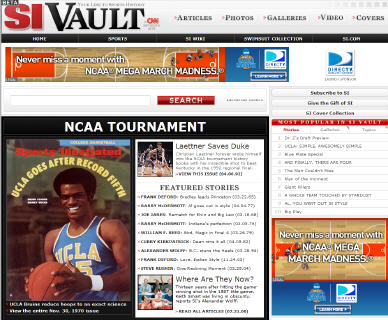
3. Apple's Roadblocks are Baaaack
And for even more fun, I encourage you to check out WSJ.com and NYTimes.com today. Apple is "roadblocking" the home pages of both again with a new Mac vs. PC ad, as they did back on Jan. 17th. This means that Apple has bought out all the home page leaderboard inventory on these 2 sites, so every time a visitor comes today, they see the same Apple ad. With all the talk about broadband video advertising, pre-rolls, overlays, etc, Apple again shows with its roadblocks how a little bit of creativity with rich media ad units can go a really long way. The ads are a great mix of interruption and opt-in and are no doubt highly effective branding units for Apple. Have a look and enjoy.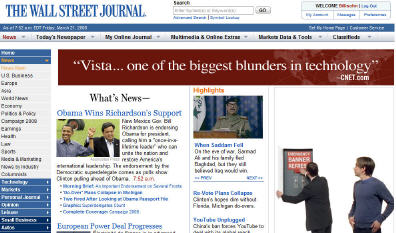
Categories: Brand Marketing, Cable Networks, Politics, Predictions, Sports, UGC, Video Sharing
Topics: Apple, Barack Obama, CNN, NYTimes.com, Sports Illustrated, Truveo, WSJ.com
